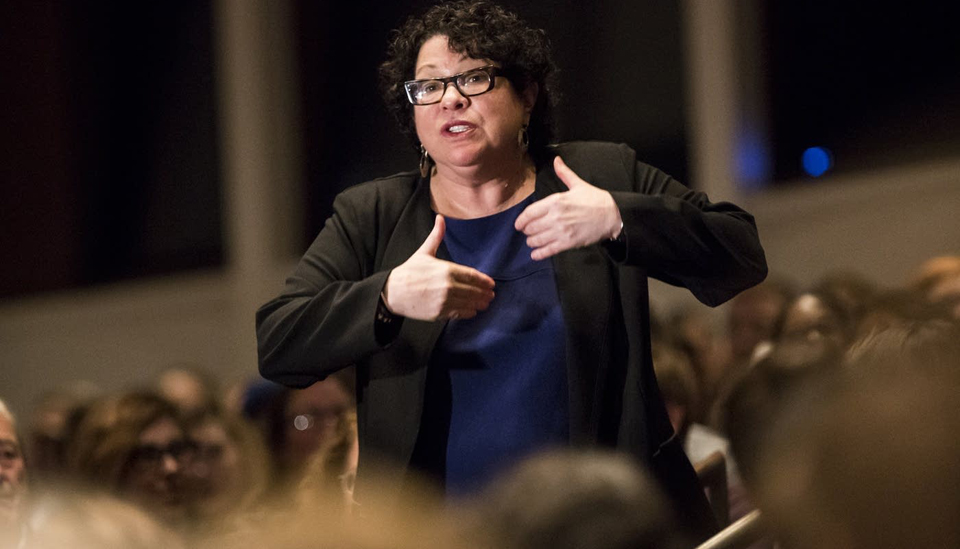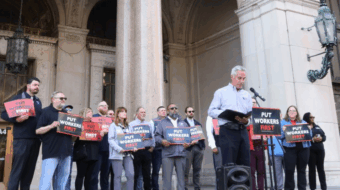
WASHINGTON—Relying on constant communication with family and friends there, U.S. Supreme Court Justice Sonia Sotomayor says Puerto Rico’s recovery from last year’s smash by two hurricanes is still decades away.
And, she adds, the island’s difficulties are compounded by “a great deal of red tape” from the federal government.
Hurricanes Irma and Maria virtually smashed the island’s schools, hospitals, civic buildings, roads and other infrastructure to smithereens. A Harvard Medical School study recently revealed 4,645 Puerto Ricans, at a minimum, died. That’s far in excess of the official death toll of 64.
The numbers, however, may understate the case. The justice said, a Puerto Rico native — who later migrated to New York City with her parents — gave a snapshot view of conditions there during an informal Q-&-A at the American Constitution Society’s luncheon on June 8 in D.C.
Sotomayor had planned to visit the island and her family members following last September’s disaster. But she recently fell and broke her left shoulder in four places, resulting in surgery, pins in her shoulder and long rehabilitation. Her left arm is still hampered.
That hasn’t prevented her from checking in with them. Her relatives came through Hurricanes Irma and Maria unscathed.
“It’s still difficult to drive around the island,” Sotomayor said. “There are sections, in the mountains, that are still not accessible. And parts of the electric grid still haven’t been restored.”
If the physical conditions are bad, the island’s economy may well be worse. The coffee industry was completely wiped out and will take seven years to recover – the time new trees need to grow to fruition – she said.
Though Sotomayor did not say so, at least one other major industry, manufacturing sterile plastic bags for hospital saline solutions, was also devastated.
Also unmentioned is the federal role, or lack of it, in encouraging industry to relocate to Puerto Rico. Over the protests of its non-voting delegate to Congress, for example, the Trump-GOP tax cut law last year treats Puerto Rico not as an U.S. commonwealth, but as a foreign country. The law slaps 20 percent tariffs on Puerto Rican-made goods sent to the U.S.
Congress has allotted billions of dollars for Puerto Rico’s recovery, but the Federal Emergency Management Agency has come under withering criticism for mismanaging aid to the island. In particular, it insists on having island residents fill out multitudinous relief applications online in a commonwealth where many lack computers and the electric power is erratic. That hampers aid.
It also hampers jobs.
The lack of jobs, plus rampant poverty even before the hurricanes hit, has resulted in a brain drain by Puerto Rican college graduates to the U.S., Sotomayor said. That will further hamper the commonwealth’s recovery, she added. “Most of the graduates of the University of Puerto Rico are coming to the States, because they can’t make a living” at home, the justice commented.
It’s not just the college grads, she added. “Five or ten years ago, the population was four million. Now it’s down to three million and I predict it will go lower,” Sotomayor said. Puerto Ricans, as U.S. citizens, can freely travel to the mainland, if they can afford it.
“It’s going to take decades for the island to rebuild. It’s challenging and, most of all, it’s sad,” she said.
The gregarious justice punctuated her talk by working the capacity crowd in the D.C. hotel’s ballroom, with her microphone pinned to her blouse and shaking hands. Sotomayor also discussed social relations between the nine justices on the Supreme Court. Ground rules at the conference, and judicial ethics, prevented her from discussing pending cases.
Sotomayor said the entry of every new justice – the latest was Trump administration nominee Neil Gorsuch – changes relationships within the court. As one example, she said that when Gorsuch first cracked a joke during the justices’ closed-door conference discussions, it fell flat, because the others didn’t “get” his sense of humor. Now they do.
And she also said that, until recent sensitization by Chief Justice John Roberts, the court’s six male justices more frequently interrupted the three female justices – Sotomayor, Ruth Bader Ginsburg and Elena Kagan – during questioning of lawyers at the High Court’s podium.
That happens in wider society, too, Sotomayor noted. And the lawyers do it, too, she said. But Roberts read a Northwestern University law professor’s study of the interruptions and has since intervened. Now he tells the lawyers “to come back to” the female justice’s question after answering the male justice’s interruption.
That drew a big cheer from the woman lawyers and law students in the crowd.










